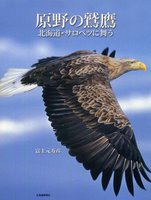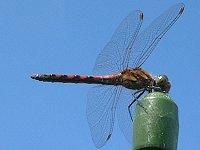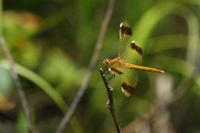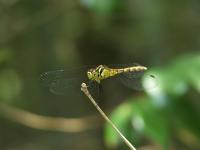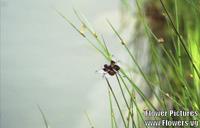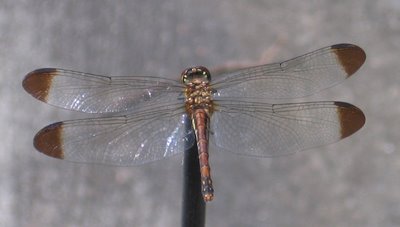:::::::::::::::::::::::::::::::::::::::::::::::::::::::::::::::::::::::::::::::::::::::::::::::::::::
The seven plants or herbs (nanakusa)
in spring and autumn.
:::::::::::::::::::::::::::::::::::::::::::::::::::::::::::::::::::::::::::::::::::::::::::::::::::::
Fern (shida) - types of ferns
***** Location: Japan
***** Season: New Year, others see below
***** Category: Plant
*****************************
Explanation
Many ferns with their regular shaped, evergreen leaves are auspicious for bringing good luck to the New Year. The leaves are used to decorate the festive table and are especially necessary for the expensive restaurants. So some villages have started to grow beautiful fern especially for food decoration purposes and the old people can earn quite a bit on the side on this new "leaves business, leaf business" happa bijinesu 葉っぱビジネス”. The people also collect red leaves of autumn for food decoration purposes, especially maple and persimmon leaves.
The village of Kamikatsu in Shikoku has made special effort with this export of leaves, see LINK below.
There are many auspicious fern varieties for the New Year, let us look at some of them.
Below are also more kigo with auspicious plants for the New Year.
Gabi Greve
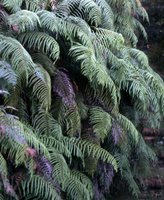
http://www.kake.ac.jp/~matsuo/Garden/photo1/urajiro.htm
For more about HERBS, see below.
aoshida 青歯朶 (あおしだ) green fern
shida wakaba 歯朶若葉(しだわかば) young leaves of fern
kigo for early summer
shida kari 歯朶刈 (しだかり) cutting fern
kigo for mid-winter
kareshida, kare shida 枯歯朶 (かれしだ) withering fern
kigo for all winter
:::::::::::::::::::::::::::::::::::::::::::::::::::::::::::::::::::::::::::::::::::::::::::::::::::::
kigo for the New Year
fern, shida しだ、歯朶
white backside, resurrection fern, urajiro 裏白
..... Gleichenia japonica, Polypodium polypodioides
mountain grass, mountain plant, yamagusa 山草
long ears, honaga 穂長
facing the other side, moromuki 諸向
to decorate the ferns, shida kazaru 歯朶飾る
This is a plant that grows over many years in the forests of Japan. Urajiro, the fern with the white on the back of each pair of leaves, is especially decorative. The white backside symbolizes the white hair of an old couple and therefore felicitous.
Look at more New Year Food from the Prince Hotel here. You can see the fern on the food.
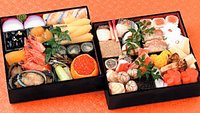
http://www.princehotels.co.jp/newyear2006/osechi/makuhari/
:::::::::::::::::::::::::::::::::::::::::::::::::::::::::::::::::::::::::::::::::::::::::::::::::::::
kigo for late spring
shida moyuru 歯朶萌ゆる (しだもゆる) fern is sprouting
:::::::::::::::::::::::::::::::::::::::::::::::::::::::::::::::::::::::::::::::::::::::::::::::::::::
葉っぱビジネス Happa Business
徳島県勝浦郡上勝町という町をご存知だろうか?典型的な少子高齢化の進む過疎の山村だったこの町が、近年にわかに話題になっている。 この町にある町の第3セクター「株式会社いろどり」。各地で第3セクターがずさんな経営で赤字を続ける中、この「いろどり」という会社は昨年度年商2億5千万円という売り上げをこの過疎の山村でたたき出しているのである。 その事業の中心は「葉っぱ」。
山に落ちている葉っぱを全国の高級料亭などに「つまもの」として出荷するというビジネスである。町の高齢者などが毎朝、山に出かけその日の相場を聞いて単価の高い葉っぱを集めてくるのである。その収入は少ない人でも20万。多い人になると80万。年収にすると1000万を越えるというから驚きだ。
http://goodspeed-group.biz/happa.htm
. WASHOKU - Decorating food with leaves .
*****************************
Worldwide use
*****************************
Things found on the way
*****************************
HAIKU
- - - - - Matsuo Basho 松尾芭蕉
誰が聟ぞ歯朶に餅負ふ丑の年
taga muko zo shida ni mochi ou ushi no toshi
Whose bridegroom is he?
Driving an ox with ferned rice cake.
The year of the Ox!
Tr. Oseko
whose bridegroom is he?
carrying rice cookies and ferns
in the year of the ox
Tr. Reichhold
Written in the year 貞享二年 - Nozarashi Kiko
It is the custom of this region of Iga Ueno to place some fern and kagamimochi rice cakes on an oxen and drive the animal around the village, led by a new bridegroom of last year. This is done to celebrate a new Year of the Ox of Asia.
Here Basho gives a good description of the regional customs.
It is also a pun with words
ushi oi - to lead an oxen, oi - ou - to carry on the back.
本句において、芭蕉は、こうした伝統文化にあやかり、貞享二年が乙丑(きのとうし)の年であることに因んで「牛」に掛け、更に、「牛追い」からの牛の縁語「追い、追ふ」を「負ふ」に掛けており、古風たる貞門俳諧を源流とする芭蕉の、当句に寄せる本情が「此古体(古風な詠み方)に人のしらぬ悦有(よろこびあり) (服部土芳編「三冊子<赤雙子>」安永五年序)の言葉で明らかにされている。.
source : www.bashouan.com/
. kagamimochi 鏡餅 for the New Year .
- - - - -
餅を夢に折り結ふ歯朶の草枕
mochi o yume ni ori musubu shida no kusa makura
I dream of rice cakes
decorated with ferns
on my pillow of grass
Tr. Gabi Greve
dreaming of rice cakes
fastened to folded ferns
a grass pillow
Tr. Reichhold
Written in 延宝9年, Basho age 38
He lives a poor life in his Basho-An and can not afford anything special for the New Year celebrations. So he can only dream of decorations while resting on his poor man's pillow stuffed with grass from the roadside.
MORE
Food, Mochi and Haiku by
. Matsuo Basho 松尾芭蕉 - Archives of the WKD .

. WKD : Pillows of the Edo period .
:::::::::::::::::::::::::::::::::::::::::::::::::::::::::::::::::::::::::::::::::::::::::::::::::::::::
名こそかはれ江戸の裏白京の歯朶
na koso kaware Edo no uraji Kyoo no shida
the names might be different -
Uraji from Edo
Shida from Kyoto
(Tr. Gabi Greve)
Masaoka Shiki
*****************************
Related words
***** Pheasant's Eye (fukujusoo) (Japan)
***** Daphniphyllum macropodum (Japan)
Kigo for the New Year
No English common-name, Yuzuri-ha in Japan is used as an “ornament for the new year to celebrate the good relationship of old and new generations.”
Other Japanese names:
yuzuriha 楪, 弓弦葉, 譲葉木 (ゆずりは)
yuzuriki 交譲木 (ゆづりき)
oyakogusa 親子草(おやこぐさ) (Parent-child plant)
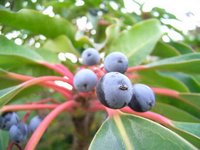
http://www.hana300.com/yuzuri.html
:::::::::::::::::::::::::::::::::::::::::::::::::::::::::::::::::::::::::::::::::::::::::::::::::::::
***** Shepherd's purse, nazuna 薺
Kigo for the New Year
One of the seven herbs (nanakusa 七草) used for the seven herbs rice gruel (nanakusagayu 七草がゆ) on January 7.
These two words are also kigo for the New Year, which co-incided with spring in the lunar calendar.
Capsella bursa-pastoris. . Hirtentäschel

kigo for all spring
nazuna no hana 薺の花 (なずなのはな) sheperd's purse flowers
..... hana nazuna 三春 花薺(はななずな)
penpengusa ぺんぺん草(ぺんぺんぐさ)penpen plant
shamisengusa 三味線草(しゃみせんぐさ)"Shamisen plant"
Its fruit resembles the bachi used when playing shamisen. 'pen pen' imitates the sound of a shamisen.
nanakusagayu 七草がゆ - 粥 Kayu, rice gruel with seven herbs
. nanoka gayu 七日粥(なのかがゆ) gruel on day seven .
konnyaku ni kyoo wa urikatsu wakana kana
Matsuo Basho
. WKD : Rice gruel (kayu 粥) .
one of the seven
in the pot on the stove...
gruel for breakfast!
- Shared by Dennis Chibi -
Joys of Japan, 2013
:::::::::::::::::::::::::::::::::::::::::::::::::::::::::::::::::::::::::::::::::::::::::::::::::::::
The word HERB, just like that, is not a kigo.
quote
A(n) herb is a plant that is valued for qualities such as medicinal properties, flavor, scent, or the like.
Herbs have a variety of uses including culinary, medicinal, or in some cases even spiritual usage. The green, leafy part of the plant is often used, but herbal medicine makes use of the roots, flowers, seeds, root bark, inner bark (cambium), berries and sometimes the pericarp or other portions. General usage differs between culinary herbs and medicinal herbs. A medicinal herb may be a shrub or other woody plant, whereas a culinary herb is a non-woody plant, typically using the leaves. Any of the parts of the plant, as well as any edible fruits or vegetables, might be considered "herbs" in medicinal or spiritual use.
Culinary use of the term "herb" is much more specific and narrow. Culinary use typically distinguishes between herbs, the leafy green parts of the plant, and spices, all the other parts of the plant, including seeds, berries, bark, root, fruit, and even occasionally leaves. Culinary herbs are distinguished from vegetables in that they are used in small amounts and provide flavor (similar to spices) rather than substance to food.
Any plant contains numerous phytochemicals that have varying effects on the body. Even when consumed in the small levels that typify culinary "spicing", there may be some effects, and some herbs are toxic in larger quantities. For instance, some types of herbal extract, such as the extract of Hypericum perforatum (St. John's wort), or the Piper methysticum (kava plant) can be used for medical purposes to relieve depression and stress. But high amounts of these herbs may lead to poisoning, and should be used with caution.
© More in the WIKIPEDIA !
:::::::::::::::::::::::::::::::::::::::::::::::::::::::::::::::::::::::::::::::::::::::::::::::::::::

nanakusagayu 七草がゆ - 粥 Kayu, rice gruel with seven herbs
google logo January 7, 2013
Introducing the Seven Herbs of Spring.
Haru no Nanakusa 春の七草
Japanese parsley or dropwort (seri せり),
Shepherd's purse, (nazuna 薺),
cottonweed (gogyo 御行, 五形、御形),
chickweed, stitchwort (hakobera はこべら), hakobe 繁縷 (はこべ) , hakuberaはくべら, ushihakobe うしはこべ、asashirage あさしらげ、mikikusa みきくさ
fam. Stellaria
Buddha's Seat(hotoke no za 仏の座) Lapsana apogonoides,
Japanese Turnip (suzuna すずな),
Long Radish (daikon))suzushiro すずしろ.
A package of these herbs sold on January 7.

http://www.asahi-net.or.jp/~IR4N-KHR/realia/nanakusauc.html
.................................................................................
obsersvance kigo for the New Year
wakana o kuusu, offering fresh greens 若菜を供す
similar to nanakusa, seven herbs of spring
..... wakano no sechi-e 若菜の節会(わかなのせちえ)
..... picking fresh greens, wakana tsumi 若菜摘 わかなつみ
fresh greens, "young greens", wakana 若菜(わかな)
first fresh greens, hatsu wakana 初若菜(はつわかな)
field with fresh greens, wakana no 若菜野(わかなの)
boat transporting fresh greens, wakana bune 若菜舟(わかなぶね)、
day of fresh greens, wakana no hi 若菜の日(わかなのひ)
..... selling fresh greens, 若菜売(わかなうり)
..... selling sheperd's purse, nazuna uri なずなうり
Natsumigawa no shinji 菜摘川の神事 (なつみがわのしんじ)
ritual of picking herbs at Natsumi river
In Yoshino seven herbs were offered at the shrine
Katte Myojin 吉野の勝手明神.
Natsumigawa is the rital name here for the river Yoshinogawa 吉野川.
It used to be a court ritual, already celebrated in poems of the Manyo-Shu collection.
quote
Katte Shrine located in Yoshinoyama, Yoshino-cho, Nara Pref. is one of the eight Myojin shrines in Yoshino.
It enshrines Oyama Tsumi no Kami and
Konohanasakuya-hime no Mikoto.
Legend has it that in 672, when Prince Oama (later enthroned as Emperor Tenmu), who had stayed in Yoshino and gathered an army to battle with the crown prince, was playing the Japanese harp in front of the hall at this temple, a heavenly maiden appeared and showed him a lucky omen.
It is also said that in 1185, when Shizuka Gozen, who parted with Minamoto no Yoshitsune in Mt. Yoshino, was caught by the pursuers, she performed elegant dance in front of the hall at this shrine to make time for her husband to escape.
The main hall was once destroyed by fire and restored in 1776, but in 2005 it was burned down again by the fire of suspicious origin. Presently, only a part of wooden structure remains and there is little possibility of the restoration of this important cultural property.
source : http://nippon-kichi.jp
君がため春の野に出でて若菜つむ
わが衣手に雪はふりつつ
Kimi ga tame Haru no no ni idete Wakana tsumu
Waga koromode ni Yuki wa furi tsutsu
It is for your sake
That I walk the fields in spring,
Gathering green herbs,
While my garment's hanging sleeves
Are speckled with falling snow.
Emperor Koko Tennoo 光孝天皇
. Ogura Hyakunin Isshu Poems 小倉百人一首 .
.................................................................................
. nanakusa matsuri 七草祭(ななくさまつり)
"festival of the seven vegetables" .
wakana shinji 若菜神事(わかなしんじ)
ritual of the seven vegetables
January 7 was also
jinjitsu 人日 day of man, day of the human being, "human day"
According to Chinese custums, the days of January were dedicated to animals and the last day of the week to man.
1日を鶏の日 chicken day
2日を狗(犬)の日 dog day
3日を猪(豚)の日 wild boar day
4日を羊の日 sheep day
5日を牛の日 cow/bull day
6日を馬の日 horse day
7日人の日 day of man
.................................................................................
母のこゑ足して七草揃ひけり
haha no koe tashite nanakusa soroi keri
I add mother's voice
to the seven herbs
of spring
Aza Yoko あざ蓉子 (1947 - )
Born in Kumamoto
.................................................................................
Daruma market on the seventh day of January
七草だるままつり Nanakusa Daruma Matsuri
at temple Zakooji, Iida town 飯田市座光寺
. . . CLICK here for Photos !
:::::::::::::::::::::::::::::::::::::::::::::::::::::::::::::::::::::::::::::::::::::::::::::::::::::
nanakusazume 七種爪 (ななくさづめ)
cutting the nails on Nanakusa day
..... nazunazume 薺爪(なずなづめ)
..... nazume 菜爪(なづめ)
muikazume 六日爪(むいかづめ)"nails on the 6th day"
nanukazume 七日爪(なぬかづめ)"nails on the 7th day"
tsumekiriyu 爪剪り湯(つめきりゆ)hot water for cutting the nails (tsume).
On January 7 the nails were cut for the first time. Hot water was poored over the seven herbs of spring and the nails made wet in the broth.
:::::::::::::::::::::::::::::::::::::::::::::::::::::::::::::::::::::::::::::::::::::::::::::::::::::
egu tsumi 恵具摘 (えぐつみ) picking arrowhead
..... egu no wakana えぐの若菜(えぐのわかな)young leaves of arrowhead
..... egu no wakabae えぐの若生(えぐのわかばえ)
..... egu no wakatachi えぐの若立(えぐのわかたち)
EGU ゑぐ is an old name of this plant, already used in the Poetry Collection Manyo-Shu. It stems from egui エグイ. Also called kuwai クワイ.
Arrowhead (kuwai) Japan. Sagittaria trifolia. Pfeilkraut
Arrowhead is considered an auspicious plant and used for New Year Dishes.
:::::::::::::::::::::::::::::::::::::::::::::::::::::::::::::::::::::::::::::::::::::::::::::::::::::

source : maruk-sozai.jugem.jp
kigo for all spring
seri 芹 (せり) Japanese parsley or dropwort
seri tsumi 芹摘(せりつみ) picking dropwort
serita 芹田(せりた) field with dropwort
seri no mizu 芹の水(せりのみず)water with dropwort
tazeri 田芹(たぜり)dropwort from a field
..... hatazeri 畑芹(はたぜり)
nezeri 根芹(ねぜり)dropwort roots
mizuzeri 水芹(みずぜり)"water dropwort"
shirozeri 白芹(しろぜり) white dropwort
dokuzeri 毒芹(どくぜり)poisonous dropwort
oozeri 大芹(おおぜり)big dropwort
obazeri 婆芹(おばぜり)
egisaizeri 益斎芹(えきさいぜり)
sawazeri 沢芹(さわぜり)swamp dropwort
..... numazeri 沼芹(ぬまぜり)
nejirogusa 根白草(ねじろぐさ)"plant with white roots"
tsumimachigusa つみまし草(つみましぐさ)
. "dropwort picking princess" , Seritsumi Hime 芹摘姫 .
and dropwort kigo in other seasons
:::::::::::::::::::::::::::::::::::::::::::::::::::::::::::::::::::::::::::::::::::::::::::::::::::::
***** Flowers of the Sheperd's purse,
nazuna no hana 薺の花
Kigo for Spring
..... hana nazuna 花薺(はななずな)
..... penpengusa ぺんぺん草(ぺんぺんぐさ)
shamisengusa 三味線草(しゃみせんぐさ) "Shamisen plant"
. . . CLICK here for Photos !
***** Seven Herbs of Autumn
***** Spices of India, an overview
*********** NEW YEAR FOOD SAIJIKI
. . . . SPRING
the complete SAIJIKI
:::::::::::::::::::::::::::::::::::::::::::::::::::::::::::::::::::::::::::::::::::::::::::::::::::::
. WKD : Kobayashi Issa 小林一茶 .
草つみのこぶしの前の入日哉
kusa-tsumi no kobushi no mae no irihi kana
sun sinking
just beyond the fist
of the herb picker
Tr. Chris Drake
This hokku is from 1/10 (Feb. 9) in 1805, probably written when Issa went to a famous park in Edo full of blooming plum trees. It's just after New Year's, a time when people traditionally pick many newly growing herbs and then eat them, usually in soups, while praying for good health during the new year. Issa may be doing the herb-picking himself or watching someone else near him pick fresh, young herbs. I take someone else to be doing the picking, with Issa watching both the person and the sun.
The fist is probably the herb-picker's left hand (assuming she [or he] is right-handed), since her left hand holds the herbs she's plucked with her right hand. Most young herbs can be picked rather easily with one hand, but if the person is pulling up a strong-rooted plant, her plucking hand might be fisted as she yanks it upward. Normally, though, the fisted hand holds the plants that have already been picked. As the person picks here and there, the setting sun nears or begins to sink below the horizon. From Issa's perspective the red sun suddenly seems to have come very close to (it's "in front of") the herb-picker and appears to be only a very short distance from the fistful of herbs. Perhaps the herbs held in the picker's fist momentarily seem to be growing out of the sun.
Or, if the fist is yanking hard to pull up a plant, the sinking sun may seem to be replenishing the earth after the plant is pulled out of it. There is no explicit religious reference in the hokku, but the sinking sun often reminded Issa of Amida Buddha's Pure Land in the west, and perhaps it goes without saying that the intimate closeness of the sun to the picker's herb-filled fist is still another indication to Issa of the actual closeness of the Pure Land to everyday life in this world.
It's hard to rule out the possibility that Issa is the one picking herbs, especially because he was probably too poor to buy herbs from a grocer.
Nine days earlier, on 1/1, he wrote:
kake-nabe mo asahi sasunari kore mo haru
dawn sun shining
even on my chipped pot --
this, too, New Year's
Issa probably has only one earthen pot with which to do his cooking, and it's chipped here and there on the edges. Issa seems grateful for the sun's light, but the normally felicitous light of the first dawn of the year ironically also shows how many cracks and chipped places the pot has.
And on 1/3 Issa wrote:
waga haru ya tadon hitotsu ni kona ichiha
my New Year's --
one ball of charcoal
a bunch of stunted greens
Most people have the largest celebration of the year at New Year's, with many decorations and delicious food and drink, but Issa has only one ball of charcoal fuel to keep him warm and one bunch of cheap, poorly growing greens that were pulled up early and virtually discarded by the farmer in order to thin his field.
Chris Drake
:::::::::::::::::::::::::::::::::::::::::::::::::::::::::::::::::::::::::::::::::::::::::::::::::::::
:::::::::::::::::::::::::::::::::::::::::::::::::::::::::::::::::::::::::::::::::::::::::::::::::::::
kigo for all summer
***** hitotsuba 一つ葉 (ひとつば) tongue fern
lit. "one leaf". Japanese felt fern
..... iwagumi いわぐみ、iwa no kane わのかわ
kara hitotsuba 唐一葉(からひとつば)hitotsuba from China
sekiran 石蘭(せきらん)"stone orchid"
sekii, seki i 石韋(せきい)
Pyrrosia lingua

. Seven Herbs of Autumn (aki no nanakusa 秋の七草) .
:::::::::::::::::::::::::::::::::::::::::::::::::::::::::::::::::::::::::::::::::::::::::::::::::::::
[ . BACK to DARUMA MUSEUM TOP . ]
[ . BACK to WORLDKIGO . TOP . ]
:::::::::::::::::::::::::::::::::::::::::::::::::::::::::::::::::::::::::::::::::::::::::::::::::::::

